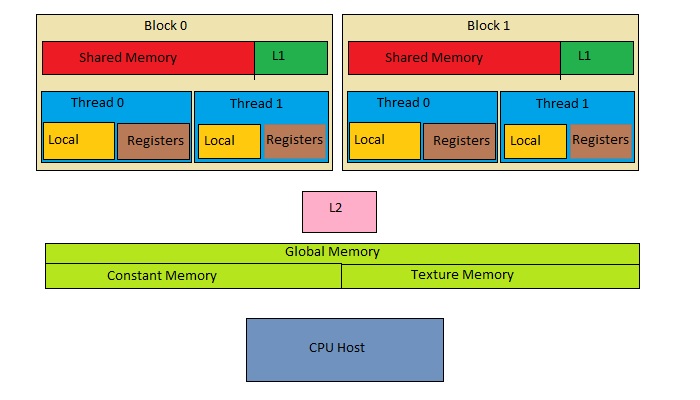In This Article
What is Local Memory?
A local memory refers to that specific part of the memory which is reserved for a single unit exclusively. Alternatively, it also defines that particular memory that handles one single program or function.
KEY TAKEAWAYS
- A local memory is the exclusive memory assigned to and used by a single processor.
- Local memory can also be allocated to a single function or a specific program.
- Local memory also refers to the memory that is utilized by a work item executed on a single unit by a work group.
Understanding Local Memory

A local memory in a computer may have several descriptions and explanations.
As already mentioned, it may represent the memory dedicated to a single unit or to that which is used by a work item in a unit, and even to the dedicated memory to a function or a program.
However, in CUDA or Compute Unified Device Architecture, local memory actually refers to the global memory.
Usually, it is referred to as the thread-local global memory.
This comes with concatenated addressing. This particular feature helps in repeating a bit faster in parallel over an array than when the data of each thread is blocked together.
Local memory is also known as local storage or simply as ‘locals’ sometimes depending on what particular type of storage device it is referred to.
A hard disk drive may be referred to as a local memory as well since it acts as a medium for storing and retrieving data and digital information.
Flash cookies or local shared objects may also be stored in a local memory of the user.
These are actually the pieces of data that the websites that use Adobe Flash in particular store in the computer of the user.
The allocation and de-allocation of local memory is typically determined and done automatically as a component of the function call system.
It plays a significant role since at a low level for the languages that use the local memory, especially the stack structure of it, almost always.
Working Process

Knowing just this much may be okay while you are doing basic programming but if you are into advanced programming, it will be a good idea to know how the local memory works.
Local memory of a computer is the programming structure which users do not think about much because everything here is automatic.
This means that they appear and are used automatically as and when required and disappear immediately and automatically when you are done using it.
Typically, the memory is called ‘local’ because they are confined to function only where they are supposed to for their entire lifetime.
The specific local memory is used when a function runs and exits when the function is completed.
For example, when there is a Square () function called, the local memory is allocated for num and result.
The statement in such cases would be like: result = num * num. It will be de-allocated when the function is over.
As said earlier, local memory represents a storage room in the memory of the computer.
Each of these will present a suitable name like sum or length in the source code.
During runtime, each of them will use a specific area within the memory of the computer to store its value behind the scenes.
However, in a program it is not the case where a variable will have an area of the memory assigned permanently.
Rather, in modern languages memory is given only when it is necessary.
This smart technology allows the assigned variable to act in the normal way as it would for storing its value.
It will be de-allocated when the memory is reclaimed by the system from the variable.
This means that it will no longer have a room to store its value.
Advantages
There are quite a few significant advantages of using a local memory and here are a few major ones.
One of the most significant advantages of using local memory is that it will meet about 90% of the memory needs of any given program.
This particular aspect translates to faster processing and throughput of the system.
It also provides a lot of convenience to the functions especially when they need some transitory memory that will exist only till the time the function completes the computation.
It is the local memory that can provide this type of temporary yet independent memory.
Another significant advantage offered by the local memory is in terms of efficiency.
When compared with memory techniques, local memory is much more efficient while allocating or de-allocating it in a timely manner.
Also, local memory is much more space efficient in the sense that it uses and recycles memory continuously as and when required.
Apart from that, the local memory also helps in ensuring that the separate components are kept independent as possible.
This is done by keeping local copies which is very good in the sense that it keeps the operations of the caller and callee functions separate, which is in keeping with the good software engineering concept.
Disadvantages
Just like any other component of a computer, the local memory also has its characteristic downsides such as:
They have a very short and strict lifetime in terms of allocation and deallocation schedule.
This may not be very helpful for those particular programs that specifically need memory to be allocated continuously even after the particular function that allocated it originally has left.
This is because the local memory will not be effective because it will be de-allocated automatically when the owning function exits.
Apart from that, a local memory tends to offer limited communication.
This is mainly because these are typically copies of the caller parameters and therefore it cannot offer the medium to the callee to communicate back to the caller.
And, most importantly, the local memory is strictly tied to their function and therefore cannot be used anywhere else apart from the place they are designated to.
The Rules
The local memory follows some strict rules during operation and here are the most significant ones.
Memory is typically allocated for all its locals as soon as a function is called.
In fact, technically, all of the locals of the function will be allocated a memory when the flow of control hits the { symbol for the function located at the beginning.
Ideally, the memory is continuously allocated to the locals undisturbed as long as the thread of control is in the owning function.
This happens even if the function passes off the thread of control for a short time while calling another function.
And finally, the local memory is deallocated when the function is completed and exits.
This means that the flow of control will exit from the function body and there will be no way to refer to the local memory any longer even if it is allocated.
What Processors Have Local Memory?
Usually, in a distributed system there is a collection of processors.
These processors typically do not share a clock or memory. It is these types of processors that come with their own local memory.
These processors usually use different communication networks such as telephone lines and high speed buses in order to communicate with each other.
These processors in a distributed system may be different in terms of their size and function and include those in the:
- Workstations
- Minicomputers
- Microprocessors and
- Large computer system built for general purpose.
Depending on the context, these processors may also be referred to by a number of other names such as:
- Nodes
- Sites
- Machines
- Computers and
- Hosts.
It is the general structure of these distributed systems as well as the communication networks that help them to interconnect and interact.
From the perspective of each of the processors in a distributed system, the relevant resources are remote but their own resources are local.
Why Processors Have Local Memory?
The processors typically have local memory because it helps them to store the required data for their operation in their own local memory.
This will save them from the hassles of having to battle with other components in the computer system for gaining access to the memory, since every component needs accessing the memory, while carrying out a protocol code.
This will also save a lot of time which will help the whole system to perform much faster.
Conclusion
The local memory offers a convenient way of computing. It is efficient for a function but it exists only for a short time till the function completes its execution.
However, in spite of the benefits offered by the local memory, there are also a few downsides which you also know about, thanks to this article.